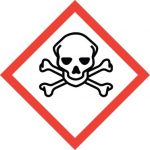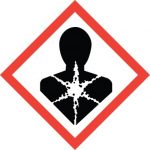1. PRODUCT AND COMPANY IDENTIFICATION
Product Identifiers
Product Name: Thorium Dioxide
Synonyms: Thorium oxide, thoria, thorianate
Formula: ThO2
CAS RN: [1314-20-1]
Identified Uses: Laboratory chemicals, manufacture of substances.
Supplier
IBI Labs
3495 N. Dixie Hwy. Unit # 8
Boca Raton, FL 33431
Tel: 561-826-0061 Fax: 561-892-8450
Emergency Telephone Numbers
INFOTRAC
USA & Canada contact number: 1-800-535-5053
International contact number: 1-352-323-3500
2. HAZARDS IDENTIFICATION
Classification of The Substance or Mixture
GHS Classification in accordance with 29 CFR 1910 (OSHA HCS)
Acute toxicity, Oral (Category 3), H301
Acute toxicity, Inhalation (Category 3), H331
Acute toxicity, Dermal (Category 3), H311
Carcinogenicity (Category 1B), H350
Specific target organ toxicity – repeated exposure (Category 2), H373
For the full text of the H-Statements mentioned in this Section, see Section 16.
GHS Label elements, including precautionary statements:
Pictogram
Signal word: Danger
Hazard Statement
H301 + H311 + H331 Toxic if swallowed, in contact with skin, or if inhaled.
H350 May cause cancer.
H373 May cause damage to organs through prolonged, or repeated exposure.
Precautionary Statements
P201 Obtain special instructions before use.
P202 Do not handle until all safety precautions have been read and understood.
P260 Do not breathe dust/fume/gas/mist/vapors/spray.
P264 Wash skin thoroughly after handling.
P270 Do not eat, drink, or smoke when using this product.
P271 Use only outdoors or in a well-ventilated area.
P280 Wear protective gloves/protective clothing.
P301 + P310 IF SWALLOWED: Immediately call a Poisson Center or physician.
P302 + P352 IF ON SKIN: Wash with plenty of soap and water.
P304 + P340 IF INHALED: Remove victim to fresh air and keep at rest in a position comfortable for breathing.
P308 + P313 IF exposed or concerned: Get medical advice and attention.
P322 Specific measures (see supplemental first aid instructions on this label).
P330 Rinse mouth.
P361 Remove all contaminated clothing.
P363 Wash contaminated clothing before reuse.
P403 + P233 Store in a well-ventilated place. Keep the container tightly closed.
P405 Store locked up.
P501 Dispose of contents/container to an approved waste disposal plant.
Hazards not otherwise classified (HNOC) or not covered by GHS:
Radioactive.
3. COMPOSITION AND INFORMATION ON INGREDIENTS, PHYSICAL AND CHEMICAL PROPERTIES
- Molecular Formula: O2Th
- Molecular Weight: 264.04 g/mol
- EC-No.: 215-225-1
- Appearance: White Powder
- Solubility: Insoluble in water
- Density, g/cm³: 9.86 g/cm³
- Melting Point, °C: 3050°C
- Boiling Point, °C: 4400°C
- Stability: Stable under recommended storage conditions
Component Classification Concentration
Thorium Dioxide
Acute Tox. 3; Carc. 1B; STOT
RE 2; H301 + H311 + H331,
H350, H373
For the full text of the H-Statements mentioned in this section, see Section 14.
4. FIRST AID MEASURES
General advice:
- Consult a physician.
- Show this safety data sheet to the doctor in attendance.
- Move out of dangerous areas.
If inhaled:
- If breathing, move the person into fresh air.
- If not breathing, give artificial respiration.
- Consult a physician.
In case of skin contact:
- Wash off with soap and plenty of water.
- Take the patient immediately to a hospital.
- Consult a physician.
In case of eye contact:
- Flush eyes with water for at least 20 minutes.
- Consult a physician.
If swallowed:
- Never give anything by mouth to an unconscious person.
- Rinse mouth with water.
- Consult a physician.
The most important known symptoms and effects are described in the labeling (see section 2 and section 9).
5. FIREFIGHTING MEASURES
Extinguishing Media
Suitable extinguishing media: Use water spray, alcohol-resistant foam, dry chemicals, or carbon dioxide.
Special hazards arising from the substance or mixture: Metal oxides.
Advice for firefighters: Wear self-contained breathing apparatus for firefighting if necessary.
6. ACCIDENTAL RELEASE MEASURES
Personal precautions, protective equipment, and emergency procedures:
- Wear respiratory protection.
- Avoid dust formation, breathing vapors, breathing dust, mist, or gas.
- Ensure adequate ventilation.
- Evacuate personnel to safe areas.
- For personal protection see section 8.
Environmental precautions:
- Prevent further leakage or spillage if safe.
- Do not let the product enter drains.
Methods and materials for containment and cleaning up:
- Pick up and arrange disposal without creating dust.
- Sweep up and shovel.
- Keep in suitable, closed containers for disposal.
7. HANDLING AND STORAGE
Precautions for safe handling:
- Avoid contact with skin and eyes and the formation of dust and aerosols.
- Provide appropriate exhaust ventilation at places where dust is formed.
Conditions for safe storage, including any incompatibilities:
- Keep the container tightly closed in a dry and well-ventilated place.
- Keep in a dry place.
Specific end uses: Apart from the uses mentioned in section 1.2, no other specific uses are stipulated.
8. EXPOSURE CONTROLS AND PERSONAL PROTECTION
Control parameters: Contains no substances with occupational exposure limit values.
Exposure controls:
- Avoid contact with skin, eyes, and clothing.
- Wash hands before breaks, and immediately after handling the product.
At any detectable concentration: Any self-contained breathing apparatus with a full facepiece operated in a pressure-demand or other positive-pressure mode.
Any supplied-air respirator with a full facepiece operated in a pressure-demand or other positive-pressure mode or other positive-pressure mode with an auxiliary self-contained breathing apparatus operated in pressure-demand or other positive-pressure mode.
Escape – any air-purifying, full-facepiece respirator with a high-efficiency particulate filler.
Any appropriate escape-type, self-contained breathing apparatus.
Firefighting and Other Immediately Dangerous to Life or Health Conditions
Use any self-contained breathing apparatus with a full facepiece respirator and a high-efficiency particulate filter.
Use any supplied air respirator with a full facepiece operated in a pressure-demand or other positive-pressure mode or other positive-pressure modes with an auxiliary self-contained breathing apparatus operated in pressure-demand or other positive-pressure modes.
Personal Protective Equipment
Eye and face protection: Face shield and safety glasses Use equipment for eye protection tested and approved under appropriate government standards such as NIOSH (US) or EN 166(EU).
Skin protection:
- Handle with gloves.
- Gloves must be inspected before use.
- Use proper glove removal technique (without touching the glove’s outer surface) to avoid skin contact with this product.
- Dispose of contaminated gloves after use following applicable laws and good laboratory practices.
- Wash and dry hands.
Body protection: Complete suit protecting against chemicals, the type of protective equipment must be selected according to the concentration and amount of the dangerous substance at the workplace.
Clothing: Employees handling radioactive substances should wear disposable overgarments, including head and foot coverings. These garments are also recommended even if the employee uses a “glove box” containment system. Certain clothing fibers may be useful in dosimetry so clothing should be kept.
The selection of appropriate gloves depends on the material, while the quality standards may vary among manufacturers.
Respiratory protection:
- Where risk assessment shows air-purifying respirators are appropriate use a full-face particle respirator type N100 (US) or type P3 (EN 143) respirator cartridges as a backup to engineering controls.
- If the respirator is the sole means of protection, use a full-face supplied air respirator.
- Use respirators and components tested and approved under appropriate government standards such as NIOSH (US) or CEN (EU).
Control of environmental exposure:
- Prevent further leakage or spillage if safe.
- Do not let the product enter drains.
9. TOXICOLOGICAL INFORMATION
Carcinogenicity:
Possible human carcinogen.
IARC: No component of this product present at levels greater than or equal to 0.1% is identified as probable, possible, or confirmed human carcinogen by IARC.
ACGIH: No component of this product present at levels greater than or equal to 0.1% is identified as a carcinogen or potential carcinogen by ACGIH.
NTP: Known to be a human carcinogen (Thorium dioxide).
OSHA: No component of this product present at levels greater than or equal to 0.1% is identified as a carcinogen or potential carcinogen by OSHA.
Reproductive toxicity:
Specific target organ toxicity – single exposure: No Data Available.
Specific target organ toxicity – repeated exposure: May cause damage to organs through prolonged or repeated exposure.
Aspiration hazard: No Data Available.
Additional Information
RTECS: No Data Available.
To our knowledge, the chemical, physical, and toxicological properties have not been thoroughly investigated.
Stomach: Irregularities based on Human Evidence.
10. ECOLOGICAL INFORMATION
Toxicity: No Data Available.
Persistence and degradability: No Data Available.
Bio-accumulative potential: No Data Available.
Mobility in soil: No Data Available.
Results of PBT and vPvB assessment: PBT/vPvB assessment not available as chemical safety assessment not required/not conducted.
Other adverse effects: No Data Available.
11. DISPOSAL CONSIDERATIONS
It is important to contact a licensed professional waste disposal service to properly dispose of this material. After use, it is essential to follow local procedures for radioactive waste disposal. It is highly recommended to check local, state, and federal regulations concerning the disposal of radioactive waste and to comply with all federal, state, and local environmental regulations.
Waste from residues/unused products: Waste disposal must follow appropriate Federal, State, and local regulations. If unaltered, this product may be disposed of by treatment at a permitted facility or as advised by your local hazardous waste regulatory authority. Residue from fires extinguished with this material may be dangerous.
Contaminated packaging: Do not reuse empty containers and dispose of them as unused products.
12. TRANSPORT INFORMATION
The U.S. Department of Transportation (D.O.T.) Code of Federal Regulations (49 CFR Parts 100-185), the International Air Transportation Association (IATA), the International Civil Aviation Organization (ICAO), and the International Maritime Organization (IMDG) are all factored into the classification and transport of material.
Proper Shipping Name:
Hazard Class:
UN/ID Number: To be determined on a case-by-case basis.
Special Information:
Packing Group:
The classification of substances with multiple hazards must be determined following the criteria presented in the regulations mentioned above. Due to the various quantities and combinations of materials being shipped at one time, the information above must be determined based on the characteristics of the specific shipment.
13. REGULATORY INFORMATION
SARA 302 Components
SARA 302: No chemicals in this material are subject to the reporting requirements of SARA Title III, Section 302.
SARA 313 Components
The following components are subject to reporting levels established by SARA Title III, Section 313:
Thorium dioxide
CAS-No. 1314-20-1
Revision Date 1993-04-24
SARA 311/312 Hazards
Acute Health Hazard, Chronic Health Hazard.
Massachusetts Right to Know Components
Thorium dioxide
CAS-No. 1314-20-1
Revision Date 1993-04-24
Pennsylvania Right to Know Components
Thorium dioxide
CAS-No. 1314-20-1
Revision Date 1993-04-24
New Jersey Right to Know Components
Thorium dioxide
CAS-No. 1314-20-1
Revision Date 1993-04-24
California Prop. 65 Components
WARNING! This product contains a chemical known to the State of California to cause cancer.
Thorium dioxide
CAS-No. 1314-20-1
Revision Date 2007-09-28
14. OTHER INFORMATION
Full text of H-Statements referred to under sections 2 and 3.
Acute Tox. Acute toxicity.
Carc. Carcinogenicity.
H301 Toxic if swallowed.
H301 + H311 +H331.
Toxic if swallowed, in contact with skin, or if inhaled.
H311 Toxic in contact with skin.
H331 Toxic if inhaled.
H350 May cause cancer.
HMIS Rating
Health hazard: 2.
Chronic Health Hazard: *.
Flammability: 0.
Physical Hazard 0.
NFPA Rating
Health hazard: 2.
Fire Hazard: 0.
Reactivity Hazard: 0.
Further information
Copyright 2014 IBI Labs. License granted to make unlimited paper copies for internal use only.
IBI Labs requires that those who receive their materials comply with 29 CFR 1910.1200(h), which mandates that employers provide employees with effective information and training about hazardous chemicals in their workplace.
The contents of this document are believed to be accurate as of the date of revision and are provided in good faith. However, it is recommended that recipients use this information as supplementary and exercise caution and judgment regarding its accuracy and suitability. Please note that IBI Labs cannot be held responsible for any damage, direct or indirect, that occurs because of using the information provided in this Safety Data Sheet.
IBI Labs makes no warranties, expressed or implied, including warranties of merchantability and fitness for a particular purpose. This information is provided without warranty, and any use of the product that does not conform to this Safety Data Sheet, or that is used in combination with any other product or process, is the user’s responsibility.
Revision Date: 06/28/2024



